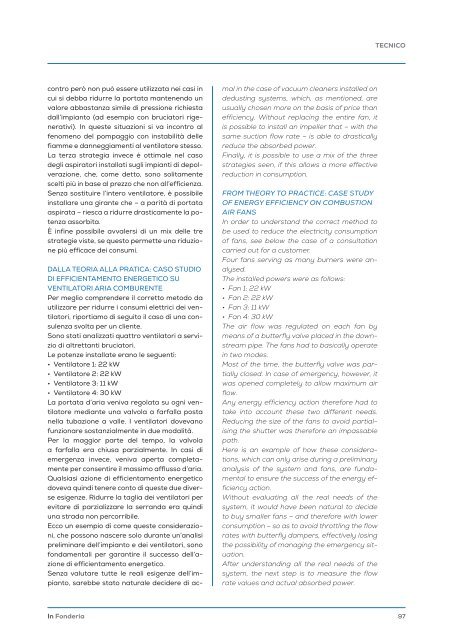In Fonderia 3 2023
Terzo numero del 2023 di In Fonderia
Terzo numero del 2023 di In Fonderia
Create successful ePaper yourself
Turn your PDF publications into a flip-book with our unique Google optimized e-Paper software.
TECNICO<br />
contro però non può essere utilizzata nei casi in<br />
cui si debba ridurre la portata mantenendo un<br />
valore abbastanza simile di pressione richiesta<br />
dall’impianto (ad esempio con bruciatori rigenerativi).<br />
<strong>In</strong> queste situazioni si va incontro al<br />
fenomeno del pompaggio con instabilità delle<br />
fiamme e danneggiamenti al ventilatore stesso.<br />
La terza strategia invece è ottimale nel caso<br />
degli aspiratori installati sugli impianti di depolverazione,<br />
che, come detto, sono solitamente<br />
scelti più in base al prezzo che non all’efficienza.<br />
Senza sostituire l’intero ventilatore, è possibile<br />
installare una girante che – a parità di portata<br />
aspirata – riesca a ridurre drasticamente la potenza<br />
assorbita.<br />
È infine possibile avvalersi di un mix delle tre<br />
strategie viste, se questo permette una riduzione<br />
più efficace dei consumi.<br />
DALLA TEORIA ALLA PRATICA: CASO STUDIO<br />
DI EFFICIENTAMENTO ENERGETICO SU<br />
VENTILATORI ARIA COMBURENTE<br />
Per meglio comprendere il corretto metodo da<br />
utilizzare per ridurre i consumi elettrici dei ventilatori,<br />
riportiamo di seguito il caso di una consulenza<br />
svolta per un cliente.<br />
Sono stati analizzati quattro ventilatori a servizio<br />
di altrettanti bruciatori.<br />
Le potenze installate erano le seguenti:<br />
• Ventilatore 1: 22 kW<br />
• Ventilatore 2: 22 kW<br />
• Ventilatore 3: 11 kW<br />
• Ventilatore 4: 30 kW<br />
La portata d’aria veniva regolata su ogni ventilatore<br />
mediante una valvola a farfalla posta<br />
nella tubazione a valle. I ventilatori dovevano<br />
funzionare sostanzialmente in due modalità.<br />
Per la maggior parte del tempo, la valvola<br />
a farfalla era chiusa parzialmente. <strong>In</strong> casi di<br />
emergenza invece, veniva aperta completamente<br />
per consentire il massimo afflusso d’aria.<br />
Qualsiasi azione di efficientamento energetico<br />
doveva quindi tenere conto di queste due diverse<br />
esigenze. Ridurre la taglia dei ventilatori per<br />
evitare di parzializzare la serranda era quindi<br />
una strada non percorribile.<br />
Ecco un esempio di come queste considerazioni,<br />
che possono nascere solo durante un’analisi<br />
preliminare dell’impianto e dei ventilatori, sono<br />
fondamentali per garantire il successo dell’azione<br />
di efficientamento energetico.<br />
Senza valutare tutte le reali esigenze dell’impianto,<br />
sarebbe stato naturale decidere di acmal<br />
in the case of vacuum cleaners installed on<br />
dedusting systems, which, as mentioned, are<br />
usually chosen more on the basis of price than<br />
efficiency. Without replacing the entire fan, it<br />
is possible to install an impeller that – with the<br />
same suction flow rate – is able to drastically<br />
reduce the absorbed power.<br />
Finally, it is possible to use a mix of the three<br />
strategies seen, if this allows a more effective<br />
reduction in consumption.<br />
FROM THEORY TO PRACTICE: CASE STUDY<br />
OF ENERGY EFFICIENCY ON COMBUSTION<br />
AIR FANS<br />
<strong>In</strong> order to understand the correct method to<br />
be used to reduce the electricity consumption<br />
of fans, see below the case of a consultation<br />
carried out for a customer.<br />
Four fans serving as many burners were analysed.<br />
The installed powers were as follows:<br />
• Fan 1: 22 kW<br />
• Fan 2: 22 kW<br />
• Fan 3: 11 kW<br />
• Fan 4: 30 kW<br />
The air flow was regulated on each fan by<br />
means of a butterfly valve placed in the downstream<br />
pipe. The fans had to basically operate<br />
in two modes.<br />
Most of the time, the butterfly valve was partially<br />
closed. <strong>In</strong> case of emergency, however, it<br />
was opened completely to allow maximum air<br />
flow.<br />
Any energy efficiency action therefore had to<br />
take into account these two different needs.<br />
Reducing the size of the fans to avoid partialising<br />
the shutter was therefore an impassable<br />
path.<br />
Here is an example of how these considerations,<br />
which can only arise during a preliminary<br />
analysis of the system and fans, are fundamental<br />
to ensure the success of the energy efficiency<br />
action.<br />
Without evaluating all the real needs of the<br />
system, it would have been natural to decide<br />
to buy smaller fans – and therefore with lower<br />
consumption – so as to avoid throttling the flow<br />
rates with butterfly dampers, effectively losing<br />
the possibility of managing the emergency situation.<br />
After understanding all the real needs of the<br />
system, the next step is to measure the flow<br />
rate values and actual absorbed power.<br />
<strong>In</strong> <strong>Fonderia</strong><br />
97














